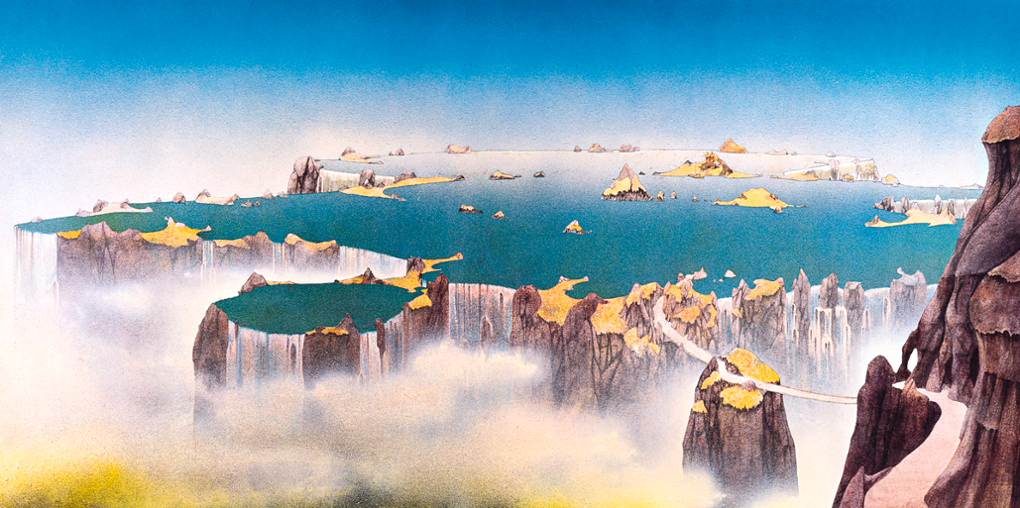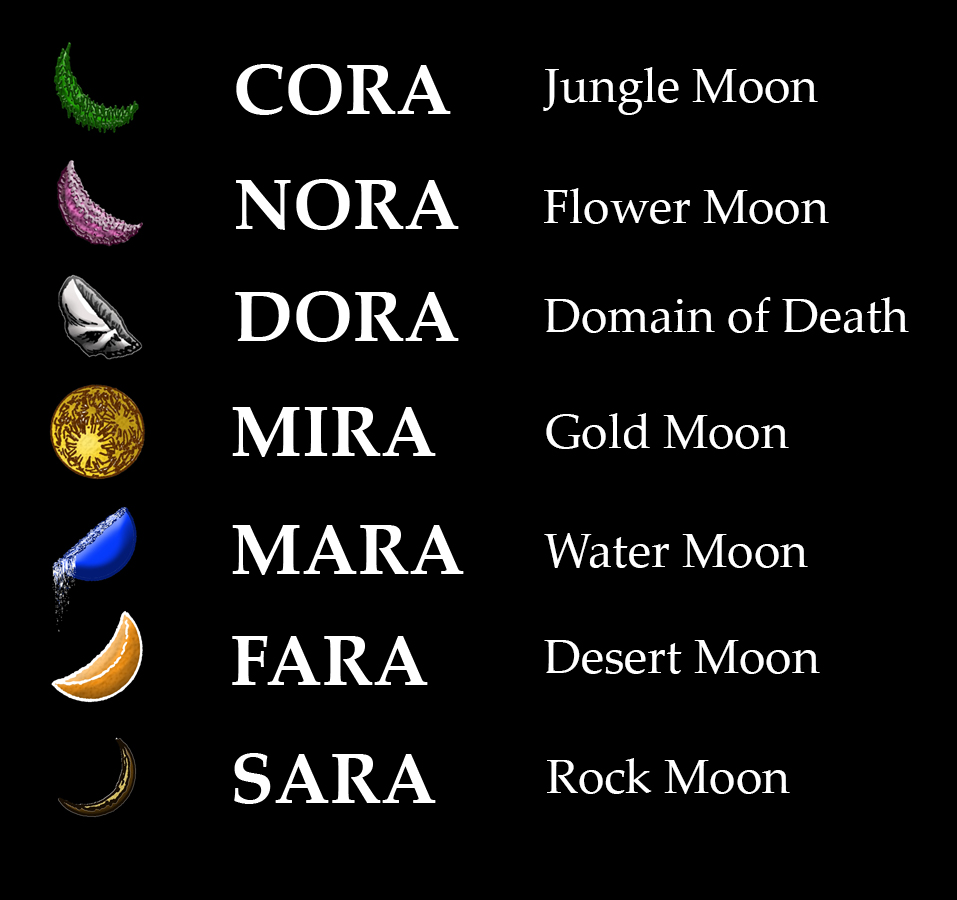Hyracanum was created by the twelve Creator Gods as an arena for their amusements and experiments. Think of these Gods as D&D players who collectively fashioned this world as a place to work out their conflicting philosophies. This is, in a poetic sense, the truth.

To the beings who inhabit Hyracanum, this is what they understand: The world and the firmament coalesced when the four elemental planes came into perfect harmonious balance. The Plane of Fire was bound inside a disc-shaped mantle formed from the Plane of Earth. The Plane of Water sprang from mountains at the center of the disc and the Plane of Air filled the surrounding space.

The Gods had willed into being a discworld suspended at the center of a vast, all-encompassing firmament. At its farthest eastern point, a mighty cannon called the Sun Gun began to launch a blazing fireball each day, arching over the discworld and terminating in the Sun Well at the opposite side of the firmament. Seven moons, known as the Seven Sisters, orbit the discworld at a 45 degree southward angle and the days of the week are named after them.

Life Finds A Way
The first beings to inhabit this new world were the Dragons, spontaneously manifesting out of the abundance of magic and raw power left over from The Creation. Perturbed by this unexpected development, the Gods created Giants in their image to dominate and exert their divine mastery over the realm, but the Giants turned out to be too willful to control and set out to conquer for themselves.
The first Giants were made from the four elements: Fire, Air (Cloud), Earth (Stone) and Water (Storm). In turn, they created smaller versions of themselves, the Frost and Hill Giants, Ogres and even Dwarves who were specifically designed for mining underground (hence their diminutive size).
At about the same time, the first Dragons created Dragonborn and Kobolds (in Master and Servant castes) to drive out Giants and their kin. Magic was on their side, as the Giants had failed to create any magic-wielding races in an effort to monopolize it for themselves. These early times were full of conflict and creation as both camps invented new monsters to fight the other side with.
During this period, Halflings came into being as an offshoot race of Dwarves. When the Giants created Dwarves, they lived on the surface as much as beneath, but, fed up with Dragon attacks from the sky, they retreated more and more underground with each generation. By the time Humans came along, there was only one strand of Dwarves who still preferred the open air and sunshine, under the constellations of the firmament. Today’s Halflings worship the Creator Gods as the power that made their makers.
Aliens from Elfland: Elves, Gnomes and Goblins
Since The Creation, Fey creatures have wandered in an out of Hyracanum with ease. The highly magical nature of Hyracanum makes it porous with gateways to other planes. Most significant of these are the twisting forests which overlap with Elfland, a realm that is virtually identical to the Feywild in standard D&D rules, but with some key differences. It is from this other world that Elves, Gnomes and Goblins came to be present in Hyracanum.
Elfland, the Forever Forest, is a limitless woodland in perpetual twilight where time appears to stand still. Twice each day, in the hour before sunrise and the hour after sunset, when conditions in Hyracanum match those of Elfland, Fey beings are able to slip between worlds. For Elves and Gnomes, the motivation is curiosity, malice in the case of Goblins, but few, if any, take up permanent residence outside their native Elfland.
Because they are known to be Good, Elves have always been tolerated, but their unpredictability and penchant for mischief makes them less than welcome in places Human and Dragonborn alike. Gnomes are a little more shy than Elves and prefer to pass unnoticed, but their reputation for industriousness makes them welcome anywhere they go.
Goblins, however, have always been a problem since the dawn of time. Unlike Elves, there is nothing good-natured in the pranks they play and they delight in sadism. They love to operate in gangs of up to a dozen, stealing over from Elfland just after sundown and causing havoc until they can slip back come dawn. They are the favoured minions of Green Hags.
- All three races are considered Fey for any appropriate rules during play.
Elves, Gnomes and Goblins do not have any gods, but they are devoted to Titania, Queen of Fairies, and Oberon, King of Shadows, their creators and the co-equal rulers of Elfland.
Humans: The Ultimate Creation
Seeing how this ever-increasing conflict threatened their world, the Gods introduced their final creation: Humans. This was their second attempt, after the Giants, to create beings in their own image, but this time with an almost limitless variety. With these creatures, the Gods hoped to re-assert their predominant role and civilize the world with a more obedient race. The results have been, shall we say, mixed.
Humans are the pre-eminent race of Hyracanum. They are the most wide-spread and multivarious, encompassing all Alignments and classes. There is no single “type” for Humans and, unlike demi-Human races, individuals are not defined by their culture. A great many of them do not even fear the Gods and openly reject them, recognizing the fact that all of Creation was intended for their entertainment. Some even go so far as to devote themselves to the Cult of the Dragon, the de facto enemy of the Creator Gods.
The World of Hyracanum is a humanocentric game setting, where Humans are the default race for NPCs. All other races are considered rare: Dragonborn have been almost wiped-out, Dwarves are withdrawn, Elves and Gnomes reside in Elfland and Halflings prefer shires more appropriate to their size than cities. The offshoot Half-Elves and Half-Orcs of Human parentage are even more exceptional, but rarest of all are Tieflings.
And then there are the monsters that Humans have created. For instance, before Humans, there were no Orcs, Hobgoblins or Bugbears. It was Human magic-users who invented them as fodder for their armies, using black magic rituals to transform a Human into an Orc or a Goblin into a Hobgoblin or Bugbear. The resulting monster is a grotesque parody of the original creature driven by the basest of lusts and purely Evil, lacking any conscience or morals.
Human civilization has existed across Hyracanum for 10,000 years. Dwarves have histories stretching back another 10,000 before that. The world now belongs mostly to Humans, though there are far more wild places than domesticated and all manner of unknown creatures to be encountered.
History
The history of the world can be divided into two periods: before Humans were created and the time since then. Both eras are roughly 10,000 years which makes Hyracanum about 20,000 years old.
The Great Equatorial Desert divides the world into northern and southern halves. This 400 mile wide band of sun-blasted sand cannot be crossed by any non-magical means and so the two halves of the world remain essentially cut off from each other, evolving independently.
In terms of cultural and technological development, the world is more or less static. It was invented as an arena for the entertainment of the Gods and they seem to prefer civilizations ranging from something like Ancient Egypt to Renaissance Europe, fostering those who fit their ideals and thwarting those that stray from them.
In 20,000 years, nobody has harnesed the power of electricty or steam or gunpowder because the Gods forbid it. They forbid it because then the game they invented their arena for would change into something else. There is a ceiling on progress enforced by the Gods with apocalyptic force.
Before Humans, the world was at war between Giants and Dragons and all that each side created to fight the other with. Everything was devoted to the conflict, be it Good versus Evil or Law versus Chaos and there is nothing much to distinguish the history of this time beyond the monsters that came out of it. The recorded history is mostly unremarkable.
The time of empires and legends did not emerge until Humans were created. Their ego and ambition drove them to make their own history which was not just another part of the endless war of Alignment, but one of exploration and artisanship. This set them at odds with both Giant-kin and Dragonborn, but the plucky and resourceful Humans managed to spread far and wide across the world, fighting for space where they wanted it and leaving for greener pastures where those conquests failed.
Humans have the most diversity of any creature in Hyracanum, but with that comes an internicine conflict that other races have trouble comprehending. Dwarves would never turn on each other, for instance, nor Elves and Gnomes, but the history of Humans is as much one of war with themselves as it is with Dragonborn and Giant-kin.
Unlike Dwarven history, which is a monolithic tapestry, each time a Human culture splinters and breaks away from the rest, they start over from scratch with their own recorded history. There is not a single Human civilization whose history spans the entire ten millennia and no two can agree what year it truly is, each one naturally prioritizing their own calendar. The Golden Empire of Zenobia is the longest standing Human civilization at (only) 2,000 years.
This splintering has led Human cultures down many different paths, some progressive, some regressive. For example, the Realm of the Five Duchies is ruled by secretive overlords who hoard magic and keep the land cut-off from the outside world. The land is like Dark Ages Britain, while a fantastic place like Cascaveda, City of Wizards, resembles Renaissance Florence with magical flourishes such as air gondolas and clockwork messenger pigeons.

